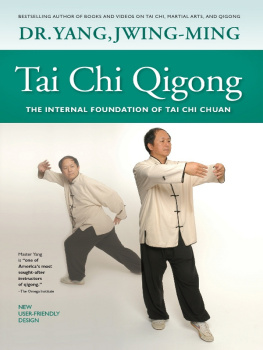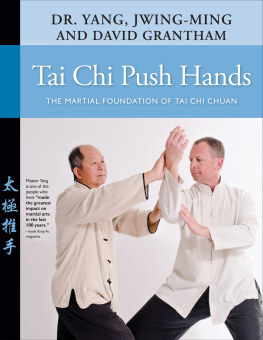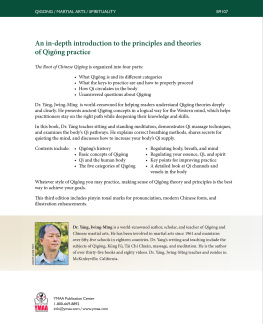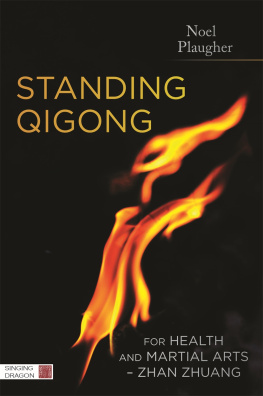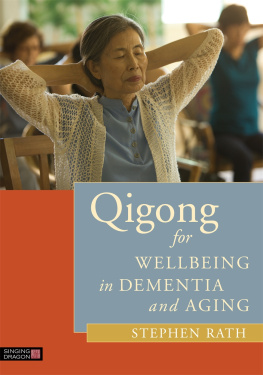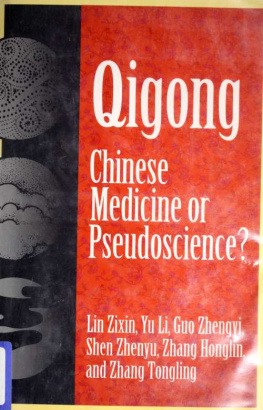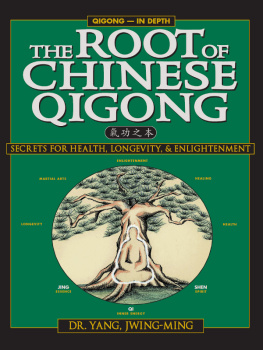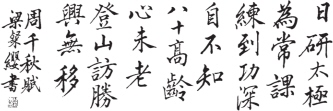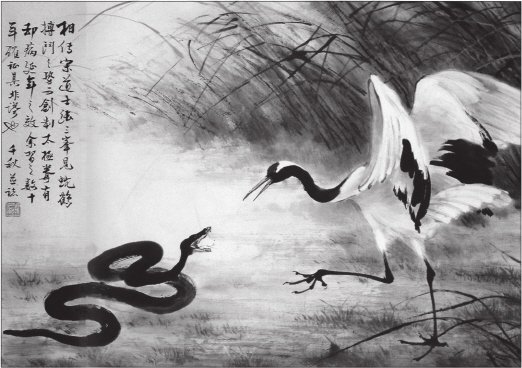
Painting by Chow, Chian-Chiu ().
Text: It is said that the Song Doaist Zhang, San-feng, after he saw the way a crane and a snake fought, created taijiquan, which is effective for sickness prevention and longevity. I have practiced taiji for many decades and have verified this saying.
I study Taiji every day as a regular lesson
I have achieved the deep Gongfu, though I didnt realize it
At the age of eighty, my heart is not yet old
Climbing mountains and visiting well-known scenes have
never lost my interest
Poetry by Chow, Chian-Chiu ()
Calligraphy by Leung, Chen-Ying ()
Translation by Dr. Yang, Jwing-Ming ()
YMAA Publication Center, Inc.
PO Box 480
Wolfeboro, NH 03894
800 669-8892 www.ymaa.com info@ymaa.com
Paperback
ISBN: 9781594392689
Ebook
ISBN: 9781594392702
Enhanced Ebook
ISBN: 9781594392801
All rights reserved including the right of reproduction in whole or in part in any form.
Copyright 1988, 1997, 2013 by Dr. Yang, Jwing-Ming
Copyedit by Dolores Sparrow and T.G. LaFredo
File management by Susan Bullowa
Proofreading by Sara Scanlon
Cover design by Axie Breen
Photos by YMAA unless noted otherwise.
Figures 2-4, 3-33, 3-34, 3-35, 3-36, 3-37, 3-38, 3-40, and 3-41 modified by Sarah Noack.
Original images copyright 1994 by TechPool Studios Corp. USA, 1463 Warrensville Center Road, Cleveland, OH 44121.
Publishers Cataloging in Publication
Yang, Jwing-Ming, 1946
Tai chi qigong : the internal foundation of tai chi chuan / Dr. Yang, Jwing-Ming. -- [3rd ed.] -- Wolfeboro, NH : YMAA Publication Center, c2013.
p. ; cm.
ISBN: 978-1-59439-268-9 (pbk.) ; 978-1-59439-270-2 (ebook)
Previous editions (1988 and 1997) issued under title: The essence of taiji qigong: the internal foundation of taijiquan.
Includes bibliographical references and index.
Summary: Tai chi chuan is an internal martial art that uses soft/round movements to redirect an opponent's incoming force. Qigong exercises are an internal method of increasing and circulating your body's energy. This book teaches tai chi qigong exercises that are useful for improving your tai chi skills and overall health. This revised edition includes a new, easy-to-follow layout. Every qigong movement is presented in 2-4 large photographs with clear instructions, and a discussion of how the movements aid in improving tai chi.--Publisher.
1. Qi gong. 2. Tai chi. 3. Qi (Chinese philosophy) 4. Medicine, Chinese. 5. Mind and body. I. Title. II. Yang, Jwing-ming, 1946-. Essence of taiji qigong.
2013952305
1311
RA781.8 .Y3634 2013
613.7/1489--dc23
The practice, treatments, and methods described in this book should not be used as an alternative to professional medical diagnosis or treatment. The authors and publisher of this book are NOT RESPONSIBLE in any manner whatsoever for any injury or negative effects, which may occur through following the instructions and advice, contained herein.
It is recommended that before beginning any treatment or exercise program, you consult your medical professional to determine whether you should undertake this course of practice.
Romanization of Chinese Words
The interior of this book primarily uses the Pinyin romanization system of Chinese to English. In some instances, a more popular word may be used as an aid for reader convenience, such as tai chi in place of the Pinyin spelling taiji. Pinyin is standard in the Peoples Republic of China and in several world organizations, including the United Nations. Pinyin, which was introduced in China in the 1950s, replaces the older Wade Giles and Yale systems.
Some common conversions are found in the following:
| Pinyin | Also Spelled as | Pronunciation |
| qi | chi | ch |
| qigong | chi kung | ch gng |
| qin na | chin na | chn n |
| jin | jing | jn |
| gongfu | kung fu | gng foo |
| taijiquan | tai chi chuan | t j chn |
For more information, please refer to The Peoples Republic of China: AdministrativeAtlas, The Reform of the Chinese Written Language, or a contemporary manual of style.
Formats and Treatment of Chinese Words
The first instances of foreign words in the text proper are set in italics.
Transliterations are provided frequently: for example, Eight Pieces of Brocade (Ba Duan Jin, ).
Chinese persons names are mostly presented in their more popular English spelling. Capitalization is according to the Chicago Manual of Style 16th edition. The author or publisher may use a specific spelling or capitalization in respect to the living or deceased person. For example: Cheng, Man-ching can be written as Zheng Manqing.
Table of Contents
In recent decades, the general populace of the United States has been facing a radical reexamination of the state of our healthcare system. Not only has this investigation included wide-ranging debates on how healthcare is delivered and who pays the bills, but also has brought us to a different vantage point for examining our philosophical approach to health and well-being. We have been forced to reexamine our involvement in our own health care by the realizations that many new diseases and dysfunctions are rising up to challenge us and that the world has become so closely connected that what affects people on one continent will soon be active throughout the global village. Swiftly we made the discovery that we must be responsible for our own state of health; we have understood that we are either our own best friend or our own worst enemy when it comes to caring for ourselves. The requirement that we care for ourselvesself-carehas brought us to a need for effective methods of regaining or maintaining our state of well-being.
We have been turning to what were first called alternative health practices and then soon termed complementary health practices. These changes in our approach are not due to the lack of skills among contemporary medicine practitioners, nor to the dearth of research and empirical proofs. Never have we had better medicines, machines, and methods, nor better proof of their effectiveness. Modern medicine has not failed us; the state of medical research and care has never been higher. Why then are so many people unhealthy? What has happened is that we allowed ourselves to become dependent upon someone else or something else to fix our ailments, our bodies, our lives. These repairs have accomplished much, but too often they are not complete or not permanent. As we look around us for models of good health, we see that people who are bright, energetic, stress-free, happyin short, healthyare those who take care of themselves, and we ask what they are doing that makes them healthy and keeps them in that state.

